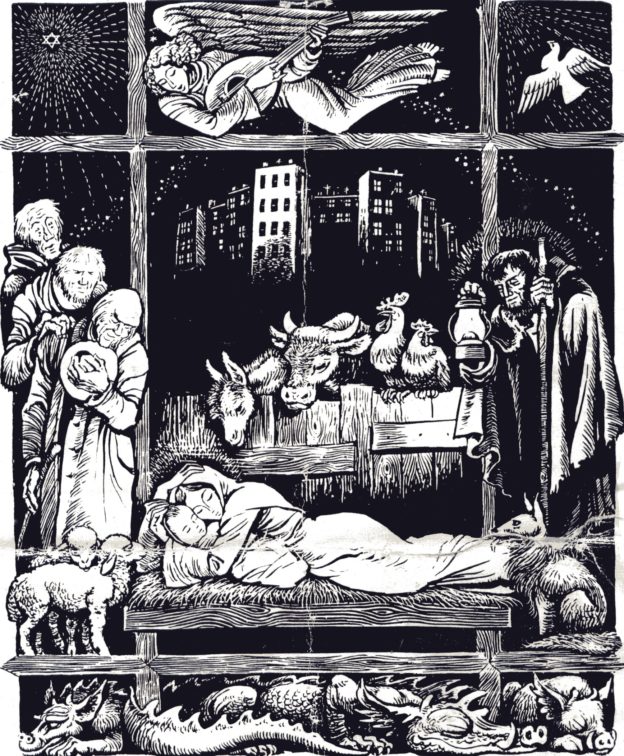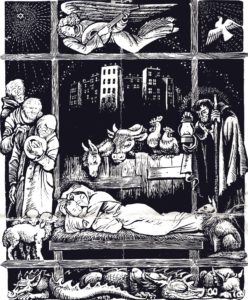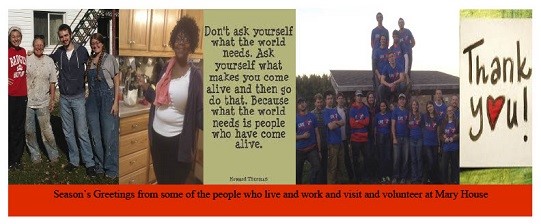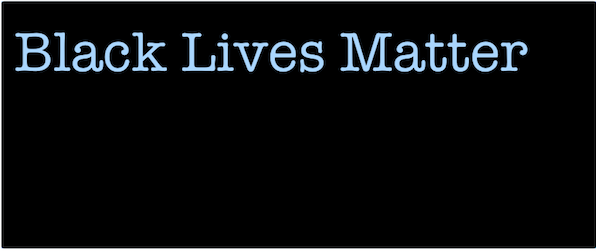
Police have killed 781 people in 2020 in the US. Black people have been 28% of those killed by police in 2020 despite being only 13% of the population. The police arrest someone every 3 seconds in the United States. Over 80% of these arrests are for low-level, nonviolent offenses. The cost of policing is a staggering $115 billion per year.It is not possible to discuss prison issues, criminal justice, or the human cost of incarceration, without addressing the impact of 400 years of structural racism and white privilege.
Hello from Mary House, September, 2020
I hope that this finds you well, during this incredibly challenging year. 2020 has been so difficult for all of us, in ways that we could never have predicted, and often can’t even imagine in each others lives. For prisoners and their families,
COVID-19 has brought added misery, risk and grief. The great majority of prisoners and their families have lost the ability to visit each other at a time when children everywhere are already haunted by fears and uncertainties that their parents can do little to alleviate.
COVID-19 case rates are higher and are escalating more rapidly in US prisons than in the US population. As of June 22, 2020, over 570 incarcerated people and over 50 correctional staff had died and the rate of infection in state and federal prisons was five and one half times that of the US population as a whole. Most of the largest coronavirus outbreaks are in correctional facilities. This reflects only state and federal prisons, and the rate of COVID transmission in jails is likely to be even higher due to overcrowding and the complete impossibility of social distancing. Yet the great majority of states have failed to release substantial numbers of nonviolent offenders in order to stop the spread inside jails.
FCI Oxford is completely closed to visitors now, and talking with families who long to visit is heartbreaking. At Mary House, we’re doing the same thing many of these families are doing – trying to keep the bills paid, hang in here, and hope for better days to come. Hopefully a combination of visiting room modifications and a lessening of the COVID-19 infection rate will result in families and loved ones being able to see each other again soon. We’re immeasurably grateful to all of you who have continued to support Mary House during this time – bills like insurance, property taxes, utilities and heat are unchanged here, even though our guests are absent, and we so appreciate your help so that we can stay ready to welcome these families back the minute the federal prison system addresses visitation.
And meanwhile, all of us who care about the particular struggles of prisoners and their families and loved ones can spend some time struggling to better understand and begin to confront the undeniable systemic racism within our criminal justice system, which incarcerates Black people at a rate nearly six times greater than it incarcerates white people. For most prisoners, incarceration begins with policing. A recent briefing by the Prison Policy Institute sheds some light on why we have the world’s largest prison population, and why Black families are so disproportionately impacted. , You can read the briefing below.
And finally, as you know, Mary House and FCI Oxford are surrounded by the beautiful green farm fields of rural Wisconsin. We are also surrounded by yard signs, and a few days ago, about two miles from the house, I came upon two large flags in front of a house. One is a Trump banner, and the other is a confederate flag. I took a photo, thinking of this newsletter and intending to share it. But it turns out that flag is so abhorrent, so disgusting, so frightening, that I can’t bring myself to print the photo. PLEASE, Vote.
Thank you all so much for your continued care and support for Mary House and the families we serve, Cassandra
The following article was published this summer by the Prison Policy Institute, and is available, along with a wealth of information, reports, slide shows and infographics explaining the humanitarian and financial impact of our criminal justice system, at https://www.prisonpolicy.org
by Wendy Sawyer, Prison Policy Institute, June 5, 2020 https://www.prisonpolicy.org/blog/2020/06/05/policingfacts/
Police disproportionately target Black and other marginalized people in stops, arrests, and use of force; and are increasingly called upon to respond to problems, such as homelessness, that are unrelated to public safety.
Many of the worst features of mass incarceration — such as racial disparities in prisons — can be traced back to policing. Our research on the policies that impact justice-involved and incarcerated people therefore often intersects with policing issues. Now, at a time when police practices, budgets, and roles in society are at the center of the national conversation about criminal justice, we have compiled our key work related to policing (and our discussions of other researchers’ work) in one briefing.
1. Nearly 1 million people in the U.S. experience the threat or use of force by police annually, and they are disproportionately Black and Latinx.
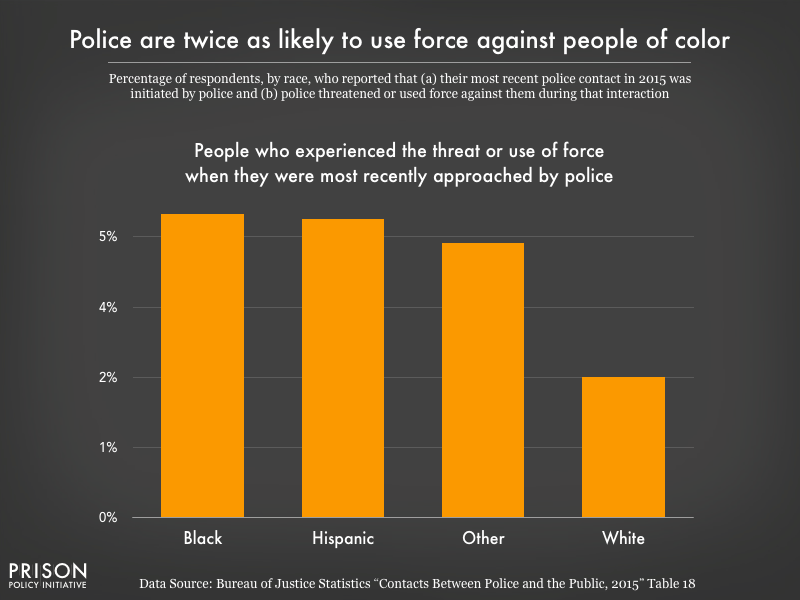
The scale of police use of force is an important fact in and of itself, made more troubling by the racial disparities evident in police stops and use of force. In a national survey, Black respondents were more likely to be stopped by police than white or Latinx respondents, and both Black and Latinx respondents were more likely to be stopped multiple times over the course of a year than white respondents. The survey also showed that when they initiated a stop, police were twice as likely to threaten or use force against Black and Latinx respondents than whites. These disparate experiences have predictable effects on public trust in police: white respondents were more likely to view police use of force as legitimate and more likely to seek help from police than were people of color.
2. Over 4.9 million people are arrested each year.
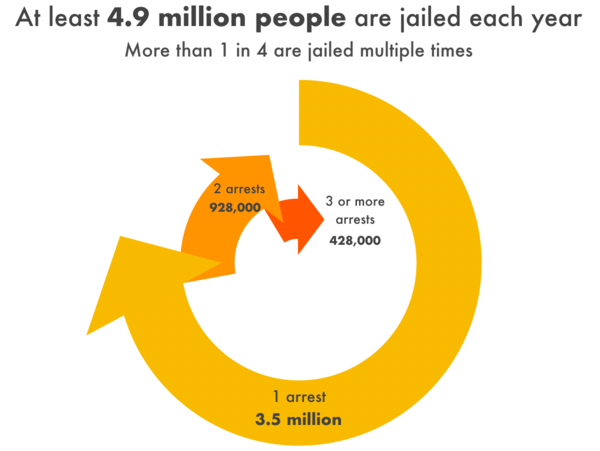
In all, there are over 10 million arrests in the U.S. each year, but many people are arrested multiple times per year. From responses to a national survey, we estimate that at least 4.9 million unique individuals are arrested and jailed each year, and at least one in four of those individuals are arrested more than once in the same year. The massive scale of these police responses means that there are millions of opportunities each year for police-civilian encounters to turn violent or fatal, and an estimated 77 million people are now saddled with a criminal record.
3. Most policing has little to do with real threats to public safety: the vast majority of arrests are for low-level offenses. Only 5% of all arrests are for serious violent offenses.
The “massive misdemeanor system” in the U.S. is an important but overlooked contributor to overcriminalization and mass incarceration. For behaviors as benign as jaywalking, sitting on a sidewalk, or petty theft, an estimated 13 million misdemeanor charges sweep droves of Americans into the criminal justice system each year (and that’s excluding civil violations and speeding). And while misdemeanor charges may sound like small potatoes, they carry serious financial, personal, and social costs, especially for defendants but also for broader society, which finances the enforcement of these minor violations, the processing of these court cases, and all of the unnecessary incarceration that comes with them.
4. Policing criminal law violations costs taxpayers over $63 billion each year.
Policing costs the public $126.4 billion per year, nationwide. In our report about the fiscal costs of mass incarceration to the government and families of justice-involved people, we used only half of that figure – $63.2 billion – because only about half of police work is devoted to criminallaw enforcement. The other half is spent on things unrelated to criminal law violations, such as traffic control, responding to civil disputes, and administration. Even at half the total cost of policing, $63.2 billion represents a huge public investment in criminalization. As many Americans are questioning the role of police in society, they should know just how much money is available to redirect to more humane community-based responses to social problems.
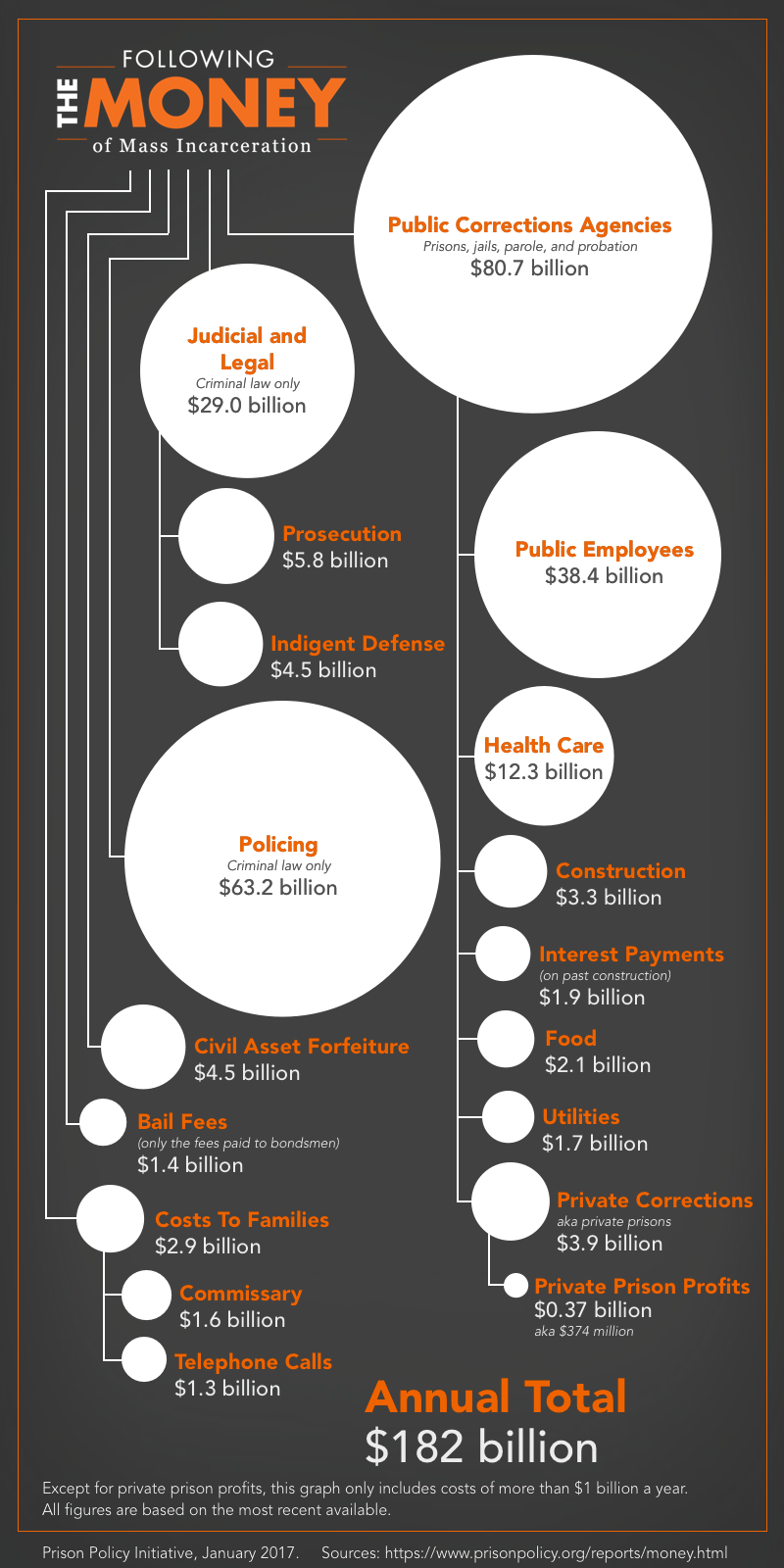
5. People who are Black and/or poor are more likely to be arrested, and to be arrested repeatedly.
People who are arrested and jailed are often among the most socially and economically marginalized in society. The overrepresentation of Black men and women among people who are arrested is largely reflective of persistent residential segregation and racial profiling, which subject Black individuals and communities to greater surveillance and increased likelihood of police stops and searches. Poverty, unemployment, and educational exclusion are also factors strongly correlated with likelihood of arrest.
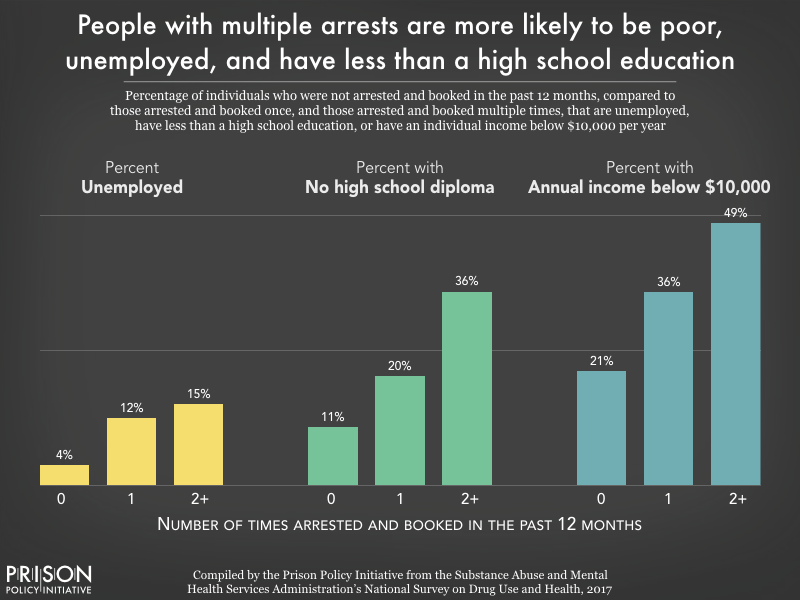
People who are arrested often have serious health needs that cannot and should not be addressed through policing or incarceration. Even a few days in jail can be devastating for people with serious mental health and medical needs, as they are cut off from their medications, support systems, and regular healthcare providers. Even worse, many people are arrested in the midst of a health crisis, such as mental distress or substance use withdrawal. History has shown that jails are unable to provide effective mental health and medical care to incarcerated people, and too often, jailing people with serious health problems has lethal consequences.
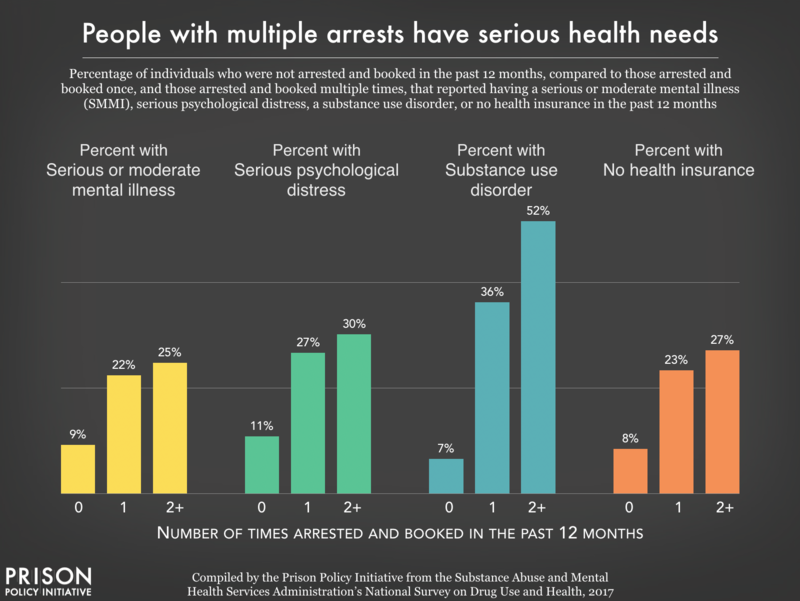
7. Women make up a growing share of arrests and report much more use of force than they did 20 years ago, with Black women most likely to be targeted. The experiences of women and girls – especially Black women and other women of color – are often lost in the national conversation about policing. But of course women, too, are subject to racial profiling, use of excessive force, and any number of violations of their rights and dignity by police. Our analysis of national data shows that women now make up over a quarter of all arrests, with an estimated 2.8 million arrests in 2018. At the same time, the use of force has become much more common among women: the number of women who experienced police use of force (about 250,000) was 3.5 times greater in 2015 compared to 1999. A closer examination of the data also reveals racial disparities in police stops, arrests, and use of force involving women. Black women are more likely than white or Latina women to be stopped while driving, and Black women are arrested 3 times as often as white women and twice as often as Latinas during police stops. Black women also report experiencing police use of force at higher rates than white or Latina women.
As the ACLU of Southern California and the Bazelon Center for Mental Health Law report, many criminalized behaviors targeted by law enforcement are related to disability: substance use (often used as self-medication for pain and other symptoms), homelessness (an estimated 78% of people in shelters have a disability), and atypical reactions to social cues, which may be interpreted as vaguely defined crimes such as “disorderly conduct.” The Ruderman Foundation reports that in police use-of-force incidents, the media and police often blame disabled people for their own victimization, especially by characterizing disabled people of color as “threatening” and “refusing to comply.”
The frequent use of police as first responders to individuals in crisis only compounds these problems. Too often, officers who are called to help individuals get medical treatment end up shooting them instead. Public funds should be redirected to community health providers to handle mental and physical health crises, rather than trying to meet this critical need with militarized police forces, who sometimes receive little training on crisis response or de-escalation.
9. Police treat Black Americans with less respect.
A Stanford University analysis of police bodycam footage from nearly 1,000 vehicle stops substantiates what Black Americans already know: police officers treat Black people differently than they do whites. This study, discussed in our briefing, finds that “police officers speak significantly less respectfully to black than to white community members in everyday traffic stops,” and that this happens irrespective of officer race, severity of the infraction, and outcome of the stop. These findings lend important context to the racial disparities observed in police encounters.
10. State and federal law enforcement practices target poor Black and Latinx residents.
Separate reports focusing on policing in Chicago highlighted two law enforcement strategies justified as ways to protect communities – drug stings and asset forfeiture – that facilitate widespread targeting of low-income communities of color. Federal agents from the Bureau of Alcohol, Tobacco, Firearms, and Explosives (ATF) arranged drug stings that set up fake drug stash houses and lured people into committing new crimes. But they didn’t single out just anyone: At least 91% of the time, agents targeted Black and Latinx people. Meanwhile, Cook County police conducted 23,000 seizures of assets connected to civil and criminal cases, a practice that is supposed to disrupt major illegal drug trades. But an analysis by Reason and the Lucy Parsons Lab showed that police officers were often taking petty property and the lowest-value seizures (valued under $100) were clustered in predominantly poor and Black communities on Chicago’s South and West Sides. These examples illustrate that at every level, the “war on drugs” functions as a war on communities of color.
Acknowledgements: This briefing was compiled by Wendy Sawyer based on previously published writing by current staffers Wanda Bertram, Alexi Jones, Wendy Sawyer, and by Policy Initiative alumns Joshua Aiken, Alex Clark, Lucius Couloute, and Elliot Oberholtzer. https://www.prisonpolicy.org/policing.html

Please Vote.
Now. As soon as possible.
You can find resources to register, ask for a mail in ballot, find your polling place, and help your friends and neighbors to vote at
https://www.whenweallvote.org/vrh/ or https://www.vote.org
Read More: Visualizing the racial disparities in mass incarceration: a slideshow of infographics https://www.prisonpolicy.org/blog/2020/07/27/disparities/#policing
Study documenting COVID spread in prisons: https://jamanetwork.com/journals/jama/fullarticle/2768249#figure-table-tab
To find out how your own state is doing on releasing nonviolent offenders to stop the spread of COVID, visit the Prison Policy Initiative’s report, Failing Grades: States’ Responses to COVID-19 in Jails & Prisons at https://www.prisonpolicy.org/reports/failing_grades.html view a map of incidents of police violence:https://mappingpoliceviolence.org see the cost of policing in major US cities: https://www.vera.org/publications/what-policing-costs-in-americas-biggest-cities





